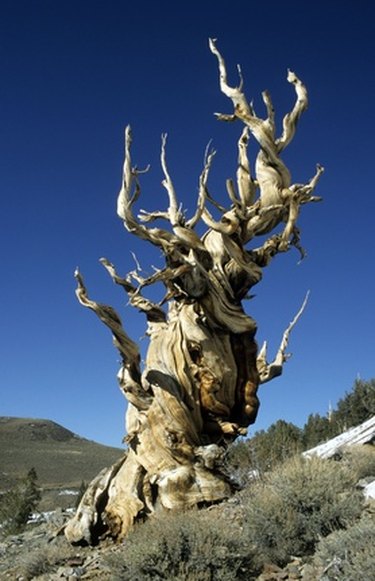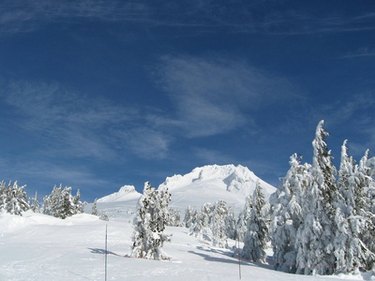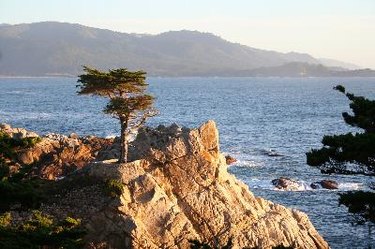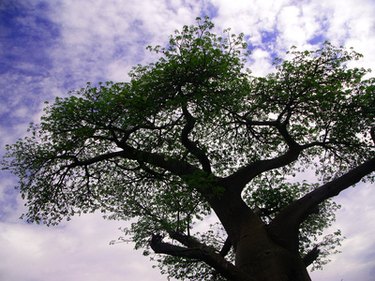
The art of Japanese bonsai -- as well as its precursor, Chinese penjing -- involves cultivating and shaping miniature trees to suggest their larger scale form and environment. There is a tremendously rich history and aesthetic curriculum to the production of these potted scenes. From a purely visual standpoint, wild trees of various species and especially various environments may grow to resemble a carefully manicured bonsai.
Krummholz Conifers
Video of the Day

Some of the harshest, most extreme environments that trees regularly inhabit are the high slopes and ridges of mountains at alpine timberline -- the uppermost point tree growth occurs. Stunted, contorted forms of trees that, in more optimal conditions, grow tall and stately are known as "krummholz," a German term meaning "crooked wood." Along upper timberlines of the American West, typical krummholz species include whitebark pine, bristlecone pine, limber pine, subalpine fir and mountain hemlock. Often, these hardy mountain trees seem three-quarters expired, with much bleached dead wood; truly perished krummholz snags can continue to stand for centuries in the dry, cold air.
Video of the Day
Appearance

These timberline conifers often manifest in remarkably bonsai-like appearances. Some of the primary environmental factors influencing the krummholz form are snow, cold and dry wind. Some have wide-splayed, matted branches hugging the ground, then a scraggly trunk with sparse, leeward foliage arcing upwards: a "flagged krummholz" pattern. The lusher "skirt" below is insulated by snow during the long winter, whereas the topmost branches contend with dessicating winds and freezing temperatures. Subalpine fir, for example, often assumes this form, with flat skirt and spire crown. In the most extreme settings, trees may adopt a cushion form, growing as prostrate masses of gnarled branches and needles. As Stephen F. Arno notes in the classic "Timberline," communal krummholz cushions may "migrate" as windward shrub-trees die and leeward individuals expand in that sheltered direction.
Other Stressed Trees

Trees may show similar form as those timberline veterans in other stressed environments. Those along ocean coasts often grow in flagged fashion, as the side exposed to salt spray and winds produces little foliage, while the leeward aspect has robust, thick-leaved branches. Trees growing in nutrient-poor soils may be stunted or warped such as Jeffrey pines, which grow on serpentine flats and slopes in the Klamath Mountains of southwestern Oregon and northwestern California.
Natural Bonsai Forms

Some tree species often grow in bonsai-like arrangements, whether or not they're inhabiting a stressed environment. The massive trunks and root-like branches of the behemoth succulents called baobabs, which inhabit tropical savannas and woodlands, resemble some of the formal, thick-stemmed varieties of bonsai. Pacific madrones, evergreen broad-leaved trees of the West Coast, often grow in sinuous-trunk fashion with airy canopies, especially when part of an oak-woodland or conifer-forest understory. Rhododendrons (which are actually a timberline species in parts of the Himalaya) and manzanitas can form twisted shrub groves that call to mind a thicket of giant bonsai.